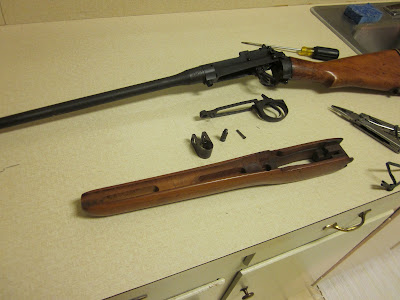 |
| Greatness |
As a first step towards realizing my goal of turning an old WWII bring-back sporterized Lee Enfield into a new school of old school (thanks
SBW) sporting rifle, I did the sensible thing; I took it apart. Not a difficult job.
First you unscrew the front sight protector. Then you look down the forestock and see a largish screw that attaches the trigger guard to the action. This is the King Screw, or "screw, front, trigger guard." You unscrew that and notice that a washer and a small metal cylinder, the bushing or "collar", come out with it. Don't throw these two seemingly insignificant items away in a fit of carelessness. Keep them. That done, you notice that there's a small screw attaching the rear of the trigger guard to the receiver socket. Unscrew that and gently ease the forestock off the action, starting from the receiver socket first. This last bit is important. Do not try and brute force the forestock off from the muzzle end; it will damage the bearing areas around the Draws and cause all kinds of trouble. After that you can remove the buttstock by unscrewing it from its socket.
 |
| Just take it all apart |
Well done. You've taken the stock-set off your Lee.
When you put it back together again, the forestock should fit snugly into the action, held tightly in place by the King Screw, which is the pivotal point, or fulcrum, in the stock's bedding. If, through some inherent wickedness on the part of the rifle, the Screw, the stock, or the Lee enthusiast, the King Screw isn't clamping the forestock tightly to the receiver, you've got trouble. Why?
 |
| King Screw |
Because the forestock will rock and rattle and when you shoot and the recoil force can act to drive the stock backwards, causing it to split and splinter into your face.
My stock rattled. The King Screw wasn't right.
So how do you fix it?
Stay tuned.
LSP






_by_Erling_Mandelmann.jpg)





















